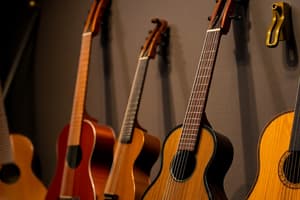Podcast
Questions and Answers
What are the natural vibrational frequencies of musical instruments known as?
What are the natural vibrational frequencies of musical instruments known as?
- Overtones (correct)
- Undertones
- Subharmonics
- Fundamentals
Which instrument shape typically produces fewer harmonics compared to a figure eight shape?
Which instrument shape typically produces fewer harmonics compared to a figure eight shape?
- Circular
- Triangular (correct)
- Oval
- Square
What is the term used to describe the unique tone colors produced by different overtone structures in instruments?
What is the term used to describe the unique tone colors produced by different overtone structures in instruments?
- Rests
- Staccatos
- Timbres (correct)
- Octaves
Which material property influences the sound production of stringed instruments like guitars and violins?
Which material property influences the sound production of stringed instruments like guitars and violins?
What internal bracing element helps transmit vibrations in hollow-bodied instruments?
What internal bracing element helps transmit vibrations in hollow-bodied instruments?
In understanding the sound production of stringed instruments, what plays a crucial role in determining their sound?
In understanding the sound production of stringed instruments, what plays a crucial role in determining their sound?
How do stringed instruments generate sound?
How do stringed instruments generate sound?
What is the role of the body of a stringed instrument in sound production?
What is the role of the body of a stringed instrument in sound production?
In what phase does the initial vibration occur in a stringed instrument?
In what phase does the initial vibration occur in a stringed instrument?
How does the shape and material of the body of a stringed instrument affect sound production?
How does the shape and material of the body of a stringed instrument affect sound production?
What is the role of the interface in sound production of a stringed instrument?
What is the role of the interface in sound production of a stringed instrument?
What causes a string in a stringed instrument to move from its resting position and vibrate?
What causes a string in a stringed instrument to move from its resting position and vibrate?
Flashcards are hidden until you start studying
Study Notes
Stringed Instruments Sound Production: Focusing on Vibrating Strings
Stringed instruments are fascinating devices that generate sound through the vibration of strings, which are typically made of materials like steel, gut, or synthetic materials. This phenomenon involves intricate relationships between the vibration patterns, the shape and material of the instrument, and the interaction with the surrounding environment. In this article, we will delve into the physics of stringed instruments and explore how vibrating strings contribute to their sound production.
The Science of String Vibrations
Stringed instruments create sounds through three primary phases:
-
Source or String: This is where the initial vibration occurs. The string can oscillate in different ways, such as plucking, striking, rubbing with a bow, or even blowing, which causes it to move from its resting position and enter into vibratory motion.
-
Medium or Body: The body of the instrument amplifies the sound produced by the vibrating string. Depending on the shape and material of the body, it reflects, absorbs, or transmits the vibrations, shaping the sound's character.
-
Interface: This is the oscillation of the instrument's body, which occurs when the vibrations from the string interact with the body's internal modes, creating resonances. This interaction allows the sound to travel through the air, providing the audible output we hear.
Harmonic Structure and Resonance
Musical instruments create sounds at their natural vibrational frequencies, known as harmonics or overtones. These frequencies depend on the size and structure of the instrument. For instance, a triangular shaped instrument produces fewer harmonics compared to a figure eight shaped instrument, while a circular shaped banjo excites the highest amount of harmonics.
When a waveform is reconstructed from the harmonics, it resembles the actual waveform. High-speed videos and mathematical models are used to study these oscillations and compare them with real-time observations.
Body Resonances and Shape
The shape of the instrument's body plays a crucial role in determining its sound production. Different shapes affect the overtone structure of the instrument, producing unique timbres or characteristic tone colors that are then defined as attractive-sounding by various societies. For example, the resonances of instruments like the violin family, guitar, harpsichord, clavichord, harp, lyre, zither, and others have different frequency ranges and ratios, contributing to their distinct sounds.
Sound Amplification and Material Properties
The material properties and finish of stringed instruments also influence their sound production. More expensive guitars and violins often use dense wood with uniform grain, as these factors reduce unwanted resonances and improve overall sound quality. Additionally, hollow-bodied instruments may contain internal bracing elements, such as sound posts, which help transmit vibrations from the top surface to the bottom, affecting the resonance frequencies and overall sound.
In conclusion, understanding how vibrating strings contribute to the sound production of stringed instruments requires an exploration of not only the physics involved but also the role of the instrument's body shape, materials, and interaction with external factors like room acoustics and performer technique. This interplay between the mechanical properties of the instrument and the musical performance creates the rich tapestry of sound that makes each stringed instrument unique.
Studying That Suits You
Use AI to generate personalized quizzes and flashcards to suit your learning preferences.




